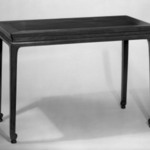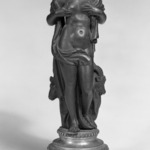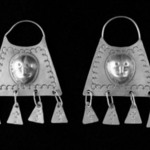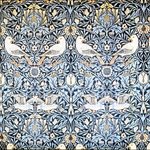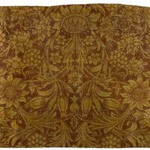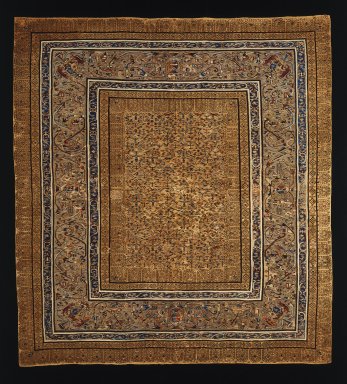
Tapestry
Arts of the Americas
Tapestries, rugs, and rich fabrics were among the most valuable goods in early colonial households, second only to jewels and precious objects in gold and silver. The private market for these textiles was stimulated once Europeans realized such works’ importance in pre-Columbian cultures.
The sixteenth-century Peruvian tapestry at the left features both European and indigenous motifs, including a spotted dog (a symbol of the Dominican order) in the central field and animals from the Peruvian ornamental repertoire, such as snakes, viscachas (Andean rodents), rabbits, and birds. Native and non-native motifs were also combined in later colonial examples, such as the tapestry at the right from Cajamarca with a mermaid, a European element that was very popular in Peru, surrounded by Andean animals.
Los tapices, alfombras y ricas telas se contaban entre los bienes más valiosos de las casas del periodo colonial temprano, luego de las joyas y objetos preciosos de oro y plata. El mercado privado para estos textiles se vio estimulado cuando los europeos se percataron de su valor para las culturas precolombinas.
El tapiz peruano del siglo XVI presentado a la izquierda incluye motivos tanto europeos como indígenas; entre ellos destacan un perro moteado (símbolo de la orden Dominicana) en el campo central y animales del repertorio ornamental peruano, tales como serpientes, vizcachas (roedores andinos), conejos y pájaros. Motivos nativos y europeos también se combinan en ejemplos coloniales posteriores, como en este tapiz de Cajamarca presentado a la derecha en el que una sirena, elemento europeo muy popular en el Perú, aparece en el centro rodeada por animales andinos.
The sixteenth-century Peruvian tapestry at the left features both European and indigenous motifs, including a spotted dog (a symbol of the Dominican order) in the central field and animals from the Peruvian ornamental repertoire, such as snakes, viscachas (Andean rodents), rabbits, and birds. Native and non-native motifs were also combined in later colonial examples, such as the tapestry at the right from Cajamarca with a mermaid, a European element that was very popular in Peru, surrounded by Andean animals.
Los tapices, alfombras y ricas telas se contaban entre los bienes más valiosos de las casas del periodo colonial temprano, luego de las joyas y objetos preciosos de oro y plata. El mercado privado para estos textiles se vio estimulado cuando los europeos se percataron de su valor para las culturas precolombinas.
El tapiz peruano del siglo XVI presentado a la izquierda incluye motivos tanto europeos como indígenas; entre ellos destacan un perro moteado (símbolo de la orden Dominicana) en el campo central y animales del repertorio ornamental peruano, tales como serpientes, vizcachas (roedores andinos), conejos y pájaros. Motivos nativos y europeos también se combinan en ejemplos coloniales posteriores, como en este tapiz de Cajamarca presentado a la derecha en el que una sirena, elemento europeo muy popular en el Perú, aparece en el centro rodeada por animales andinos.
MEDIUM
Camelid fiber and cotton
DATES
late 16th century
PERIOD
Colonial Period
DIMENSIONS
92 x 84 9/16 in. (233.7 x 214.8 cm)
storage (supporting tube length circa 2017): 96 in. (243.8 cm) (show scale)



COLLECTIONS
Arts of the Americas
ACCESSION NUMBER
40.134
CREDIT LINE
Charles Stewart Smith Memorial Fund
EXHIBITIONS
MUSEUM LOCATION
This item is not on view
CAPTION
Tapestry, late 16th century. Camelid fiber and cotton, 92 x 84 9/16 in. (233.7 x 214.8 cm). Brooklyn Museum, Charles Stewart Smith Memorial Fund, 40.134. Creative Commons-BY (Photo: Brooklyn Museum, 40.134_SL1.jpg)
IMAGE
overall, 40.134_SL1.jpg. Brooklyn Museum photograph
"CUR" at the beginning of an image file name means that the image was created by a curatorial staff member. These study images may be digital point-and-shoot photographs, when we don\'t yet have high-quality studio photography, or they may be scans of older negatives, slides, or photographic prints, providing historical documentation of the object.
RIGHTS STATEMENT
Creative Commons-BY
You may download and use Brooklyn Museum images of this three-dimensional work in accordance with a Creative Commons license. Fair use, as understood under the United States Copyright Act, may also apply.
Please include caption information from this page and credit the Brooklyn Museum. If you need a high resolution file, please fill out our online application form (charges apply).
For further information about copyright, we recommend resources at the United States Library of Congress, Cornell University, Copyright and Cultural Institutions: Guidelines for U.S. Libraries, Archives, and Museums, and Copyright Watch.
For more information about the Museum's rights project, including how rights types are assigned, please see our blog posts on copyright.
If you have any information regarding this work and rights to it, please contact copyright@brooklynmuseum.org.
RECORD COMPLETENESS
Not every record you will find here is complete. More information is available for some works than for others, and some entries have been updated more recently. Records are frequently reviewed and revised, and we welcome any additional information you might have.



